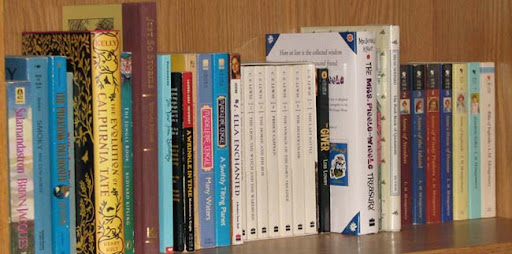Selznick, Brian. 2011. Wonderstruck. New York: Scholastic. ISBN: 9780545027892.
Summary:
Two different plots unfold throughout this book and weave together at the end. Ben's story is set in 1977 and is told almost entirely in words. Rose's story occurs in 1927 and is told in pictures. Rose is deaf, and her divorced parents don't understand her. She runs away across the harbor to New York City, where she finds her kind older brother in the American Museum of Natural History, and he takes care of her. Ben, who was born deaf in one ear, loses his hearing in the other ear because of lightning through a telephone wire. His mother had recently been killed in an accident, and Ben takes off alone from Minnesota to New York City, chasing a clue that he hopes will lead him to his long-lost father. He makes a friend and hides out in the American Museum of Natural History. He learns more about his father and the connection that brought his dad to Gun Lake, Minnesota years ago. The stories continue converging until the reader discovers, along with the characters, that Rose is Ben's grandmother.
Analysis:
Selznick is a master at telling stories and showing action through pictures, and the pencil illustrations are wonderfully-drawn and are crucial to the story. Rose's story isn't told at all in words until the end, but the reader understands everything from the pictures. The facial expressions and body language convey so much emotion. The quality of the text is also very good, and readers will sympathize with Ben as he loses his hearing, sets off on a potentially dangerous journey, and tries desperately to find his father. The author creates mini-cliffhangers throughout the book as he alternates between stories, and he matches similarities between Rose's and Ben's adventures (such as showing up at the museum). It’s not difficult to alternate between the stories, and the only danger is going through the pictures too fast and not noticing the marvelous and intricate details.
In an extensive note in the back of the book, Selznick describes the research he did (including interviews) in his attempt to accurately portray Deaf culture. He includes little details like Rose's horrified reaction to the end of silent movies in 1927. Before "talkies," deaf and hearing people could watch movies in much the same way. He also shows the tendency in the 1920s to teach deaf people to speak and lip-read while forbidding sign language. Rose does eventually learn sign language, though, and Ben’s friend Jamie teaches him to sign the alphabet. Although I personally can't know for sure, I think Deaf readers would be proud to find their culture portrayed in this book.
Through the text and illustrations, but especially the illustrations, the author also conveys the culture of New York City: the subway with its graffiti, apartment buildings, the rush of crowds, theaters, homeless people, Times Square, the Panorama, and of course, lots of details about the American Museum of Natural History.
Reviews/Awards:
“A thing of wonder to behold…an emotional experience that neither the words nor the illustrations could achieve on their own.” School Library Journal starred review
“Brian Selznick proves to be that rare creator capable of following one masterpiece — The Invention of Hugo Cabret, — with another even more brilliantly executed.” Washington Post
Connections:
*Scholastic has a great companion website for the book, filled with fun information for children. Explore it! http://www.wonderstruckthebook.com/



